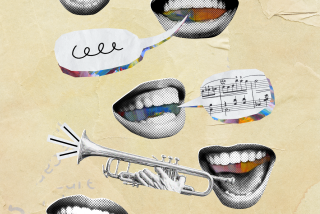ORANGE COUNTY CHILDREN IN THE ARTS : Entertaining and Teaching--It’s the Same to Musical Couple
Greg and Margie Mirken, folk musicians from Mission Viejo, sat on the edge of a carpeted stage one recent morning, surrounded by instruments and facing a small amphitheater full of curious fourth-graders.
At Irvine’s Northwood Elementary School for an Orange County Philharmonic Society-sponsored show-and-tell program about traditional American music, the Mirkens slid bits of social history and commentary in between the songs.
In Irvine, Margie noted, “we don’t have a lot of jobs that are dangerous. Here, the most dangerous (job hazard) we might have would be a computer fire. But I’m sure you have bad dreams, so you can empathize with this.” She launched into “The Dream of the Miner’s Child,” a plaintive song in which a young girl dreams of her father’s death:
Oh daddy don’t go to the mine today .
Dreams so often come true .
Oh daddy, dear daddy, please don’t go away.
I never could live without you.
For the past eight years, the Mirkens have been part of the Philharmonic Society’s 15-year-old music enrichment program, one of 12 youth programs sponsored by the society’s committees. Through this program, a variety of professional musicians are given small honorariums by the committees to perform for fourth-grade students throughout the county at no charge to the schools.
As what they jokingly call “The Greg and Margie Show,” the Mirkens visit 15 to 20 schools a year. They also perform traditional music at the Old Dana Point Cafe every Sunday evening as part of a group called Blackthorn. Occasionally, they play at the Old Time Cafe in Leucadia and at weddings, parties and senior centers in addition to running their 12-year-old music store, Shade Tree Stringed Instruments, in Mission Viejo.
At Northwood Elementary, they held about 80 students entranced. While 38-year-old Greg strummed a 70-year-old mandolin, 36-year-old Margie played a lively tune called “Mississippi Sawyer” on a banjo. Can you tell, she asked the children, “that by the way the music makes you feel, it’s dance music?”
They talked about their instruments as they played them. “Mandolins and violins came from Italy, and guitars originally came from Spain,” Greg said. “It’s hard for anybody to believe, but around the turn of the century, the mandolin was as cool as the electric guitar is today. So if you were cool, you played the mandolin. I’m just about 90 years behind the times.”
“Where do you think banjos came from?” he asked. “France?” “No, not France.” “Spain?” “No.” “Africa?” said a boy near the front. “Right! He gets the prize for the day,” Greg declared.
Although African slaves were not able to bring their banjos with them when they were taken to America, Greg said, they “brought the idea of the banjo in their heads” and re-created the instrument with gourds, animal skins and dried entrails.
Later in the fast-paced, 45-minute program, the Mirkens introduced the students to an Appalachian dulcimer, a Dobro guitar (which looks like a regular guitar with a hubcap in the middle) and a concertina, a small precursor of the accordion that was popular around the turn of the century.
“How many of you are learning how to play an instrument?” Margie asked. Many hands shot up. “Are you learning it from books? Do you know there’s another way to make music and that’s just to make it up?”
The Mirkens packed up and sped off to nearby El Toro Marine School, where they presented a similar show to another, even more enthusiastic, young audience. A boy asked them how long it had taken them to learn to play so many instruments.
“I don’t feel like I’ve finished learning yet,” Margie answered.
Carol Lloyd, a fourth-grade teacher at El Toro who brought her classes to hear the Mirkens two years in a row, said she had supplemented the performances with classroom instruction. Most of her students “love music,” she said, “so any form of it we have at the school really enhances learning for them.”
Greg said he and Margie feel “honored” that the Philharmonic Society “bothers having something as folksy as us, something other than the ‘proper music.’ ” Most of the other musicians involved in the enrichment program, he noted, are classically trained.
“If the kids don’t hear the kind of music we play, it’s going to die,” Margie said. “The hope with the schools is that the kids get to hear an acoustic music that sounds beautiful” and will become interested in it.
“That’s why we don’t use microphones at these things,” Greg said. “We want the sound to be the actual instrument.”
“People respond to beautiful instruments, (but) life is so many synthesizers now,” Margie said. “Computers are easier to use than musical instruments. . . . One guy with a synthesizer can make all the sounds on a record album.
“But I can tell the difference.”
More to Read
The biggest entertainment stories
Get our big stories about Hollywood, film, television, music, arts, culture and more right in your inbox as soon as they publish.
You may occasionally receive promotional content from the Los Angeles Times.










